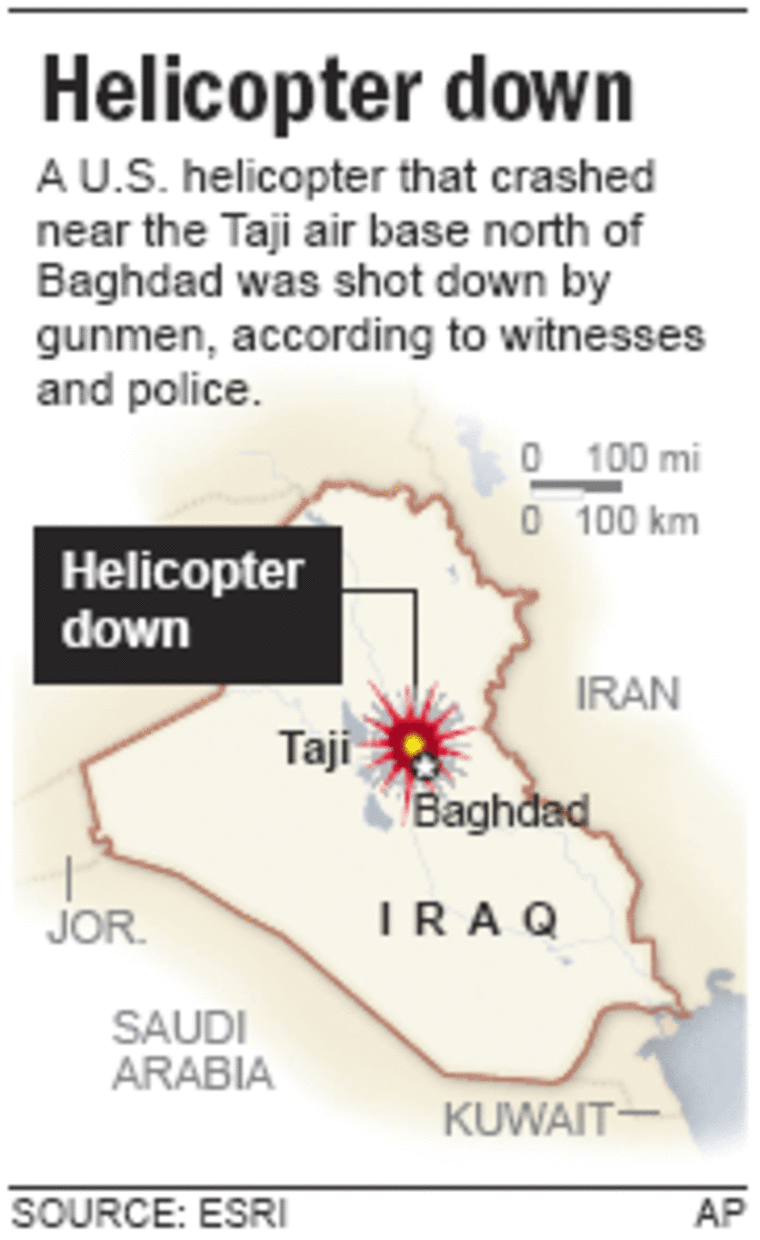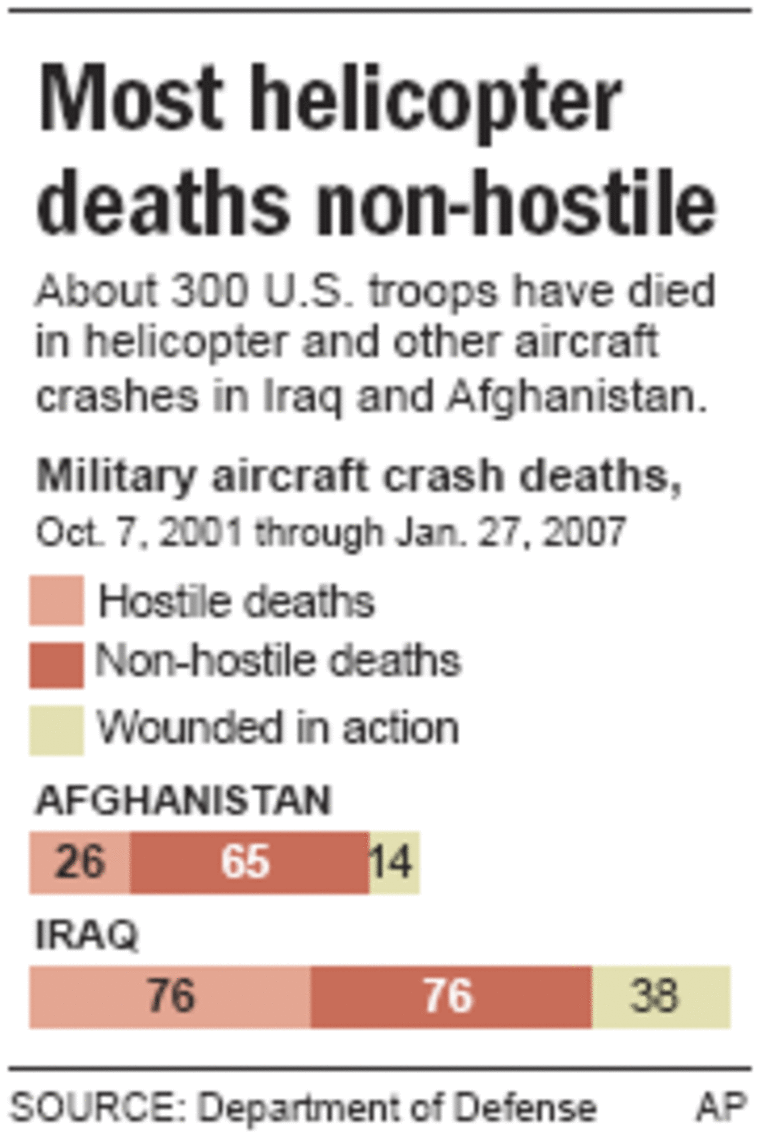A U.S. helicopter went down Friday in Iraq — the fourth in two weeks — killing two soldiers on board, and America’s top general acknowledged that its aircraft were increasingly in danger from ground fire.
Witnesses and local police said two helicopters were flying together when gunmen opened fire, sending one of the aircraft crashing to the ground, smoke trailing behind it, near Taji, an air base just north of Baghdad.
The military, acknowledging the loss of the Army helicopter in a statement, did not identity the type of aircraft nor say what caused it to go down.
Gen. Peter Pace, chairman of the Joint Chiefs of Staff, said Friday that clearly, “ground fire ... has been more effective against our helicopters in the last couple weeks.” The comments marked the first time a military official has publicly acknowledged the recent crashes were caused by ground fire.
“I’ve taken a hard look at that, don’t know whether or not this is statistically what’s going to happen over time, when you’re flying at that level and people are shooting at you, or if this is some kind of new tactics or techniques that we need to adjust to.”
Three other helicopters — two military and one civilian — have been lost in Iraq since Jan. 20. All three were believed to have been shot down.
The U.S. military relies heavily on air transportation in Iraq to avoid roadside bombs and insurgent ambushes and the recent spate of losses has raised questions about whether Sunni insurgents and Shiite militias may have stepped up attacks on helicopters or may have received new supplies of shoulder-fired anti-aircraft weapons. Sunni insurgents are already known to have anti-aircraft weapons as well as rocket-propelled grenades and heavy machine guns.
Since May 2003, the U.S. military has lost 54 helicopters in Iraq, about half of them to hostile fire, according to figures compiled by the Brookings Institution.
Other military action
U.S. forces, meanwhile, said 18 insurgents were killed in fighting Thursday night and Friday after insurgents opened fire on the Americans from several positions in Ramadi, 70 miles west of Baghdad, the military said. No civilian or U.S. casualties were reported, the military said.
Ramadi, the capital of the western province of Anbar where Sunni insurgents remain well-entrenched, has seen some of the bloodiest street battles of the war.

The U.S. forces returned fire with machine guns, tanks and finally a missile, which struck the intended target, killing at least 15 insurgents.
Insurgents renewed their attacks on Friday, prompting U.S. forces to fire another missile that killed at least three insurgents.
Elsewhere in Anbar, gunmen assassinated the Sunni chairman of the Fallujah City Council, Abbas Ali Hussein, an outspoken critic of al-Qaida, the third council leader to be killed in a year.
The U.S. military said six more troops were killed Thursday, two in fighting in Anbar province, one of an apparent heart attack and three in vehicle accidents.
The deaths raise to at least 3,092 members of the U.S. military have died since the Iraq war started in March 2003, according to an Associated Press count. At least 2,480 died as a result of hostile action, according to the military’s numbers.
Hillah bombing aftermath
Iraqi officials in Hillah, a Shiite city about 60 miles south of Baghdad, announced a three-day mourning period after Thursday’s devastating suicide attack. Police spokesman Capt. Muthanna Khaled said at least 73 people were killed and 163 wounded.
Police and witnesses said the two bombers strolled into the central Maktabat market about 6 p.m. when the area was packed with shoppers buying food for the evening meal.
Police said an officer, Ahmed Abed Majood, became suspicious and grabbed one of the bombers but he managed to detonate his explosives. His partner then blew himself up too.
The blasts sent bodies hurling through the air and set fire to wooden stalls where vendors sold fruits and vegetables, witnesses said. Some shoppers fled screaming, while others stopped to help rescuers carry away the wounded.
No group claimed responsibility, but many residents blamed Sunni insurgents. The Shiite city, located in a religiously mixed province, was the scene of one of Iraq’s deadliest attacks — a February 2005 suicide car bombing that killed 125 people.

“I was hit by the first explosion. I fell on the ground and that is the reason that I was saved from the second explosion,” one wounded man said from his hospital bed.
In violence Friday, a roadside bomb struck a police patrol in the northern city of Mosul, killing one officer, police said.
But the capital was relatively calm amid a weekly three-hour vehicle ban to prevent car bombings during the traditional Islamic religious services.
Najaf curfew
Authorities also imposed a daytime vehicle ban Friday in the Shiite holy city of Najaf following last weekend’s battle between Iraqi-U.S. troops and a messianic Shiite cult that left more than 200 people dead, said Ahmed Duaebil, spokesman for the Najaf province.
Officials have said the cultists planned attacks during Tuesday’s Ashoura commemoration to try to bring back the “Hidden Imam,” a descendant of Islam’s Prophet Muhammad who disappeared as a child in the 9th century. Shiites believe that he will return one day to bring justice and peace.
Much conflicting information has emerged about the cult — the “Soldiers of Heavan” — including several names for the so-called leader, who Iraqi authorities said was among those killed in the fighting.
Shiite cleric Sadralddin al-Qubanji, a member of the Supreme Council for the Islamic Revolution in Iraq, said the cult leader was a member of Saddam Hussein’s feared security agency, the Mukhabarat.
He claimed the group was established in 1993 and supported by Saddam’s ruling Baath Party to exploit internal rivalries among Shiites.
“The Baath Party has been saving this person in order to create a Shiite-Shiite sedition,” al-Qubanji said during his Friday sermon in Najaf.
He also said two other groups with offices in Najaf have adopted the same ideology as the cult and called upon security forces to prevent similar attacks.